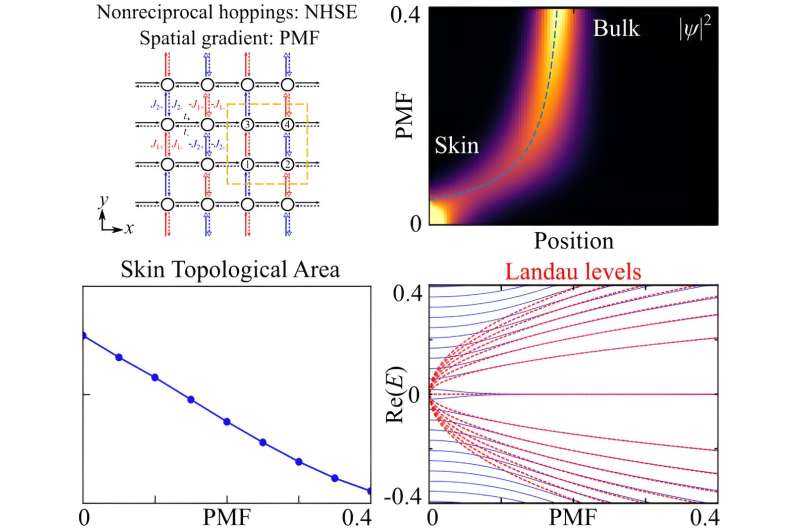This article has been reviewed according to Science X's editorial process and policies. Editors have highlighted the following attributes while ensuring the content's credibility:
fact-checked
trusted source
proofread
Researchers suppress non-Hermitian effects via 'fake' magnetic fields

Due to the presence of non-Hermitian components, wave intensities tend to localize at the system boundary, namely the non-Hermitian skin effect. The skin behavior is protected by topology, making it insensitive to minor changes. Nevertheless, it has recently been shown that the non-Hermitian skin effect can be suppressed by real magnetic fields.
Zhang, Xue, and Zhang's graduate student Hau Tian Teo wondered, "Can a 'fake' magnetic field—pseudomagnetic field—also suppress the non-Hermitian skin effect?" The team then performed theoretical calculations on a two-dimensional lattice array to study the topology and movement of the skin behavior.
By switching on the pseudomagnetic field, the team discovered that the skin states can be pushed into the bulk. "This movement from skin to bulk can be precisely traced by a theoretically predicted trajectory," Teo suggests. In addition to the movement, the suppression is reflected in the reduction of topological number.
Although this is a non-Hermitian setting, the team also found that the pseudomagnetic field can also recover the flat energy levels as if it is a Hermitian system. "Together with the precise location of the state, we can even trace its flat and quantized energy levels. This could contribute to the precise localization of states in space and energy," Xue says.
"These exciting new results provide a time-reversal invariant way to control non-Hermitian systems. As our 'fake' magnetic field is unchanged if we reverse the arrow of time, this protocol could be promising in controlling classical wave devices that are able to host the non-Hermitian skin effect but inert to magnetic fields," Zhang suggests.
The work entitled "Pseudomagnetic suppression of non-Hermitian skin effect" was published in Science Bulletin.
The study was led by Prof. Baile Zhang (School of Physical and Mathematical Sciences, Nanyang Technological University) and Prof. Haoran Xue (Department of Physics, The Chinese University of Hong Kong).
More information: Hau Tian Teo et al, Pseudomagnetic suppression of non-Hermitian skin effect, Science Bulletin (2024). DOI: 10.1016/j.scib.2024.04.023
Provided by Science China Press





















